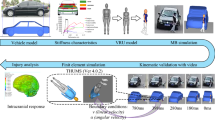Abstract
This study lies within the scope of passive road safety, and more particularly injury mechanisms of the abdominal area. The finite element modeling, which makes it possible to simulate a road accident and to observe the possible bone fractures or internal tissue injuries, allows large projections in the comprehension of injury mechanisms. However, the digital models already available and used in accidentology do not offer as one very simplified description of the diaphragm, as well for its geometry as for its bracing aspect and the modifications that this could induce in the behavior of abdominal organs and vessels at impact. In order to develop an accurate model of diaphragm for road safety research, a 3D reconstruction was performed, based on a sitting post-mortem Human subject sections. The resulting geometry was then turned into a segmented mechanical component (using the finite element method) and included in a full human model already available. The result is a valuable tool to improve the knowledge of injury mechanisms involved in car crashes at the abdominal level.








Similar content being viewed by others
References
Banerjee A (1989) Seat belts and injury patterns: evolution and present perspectives. Postgrad Med J 65:199–204
Behr M, Arnoux PJ, Serre T, Kayvantash K, Brunet C (2005) Modelling active muscle behavior for emergency braking simulations. Computat Fluid Solid Mech 2005:60–64
Bergqvist D, Hedelin H (1976) Roll seat belt induced injury of the duodenum. J Trauma 16:390–39472
Chabert L, Ghannouchi S, Cavallero C, Bonnoit J (1996) Anatomical study and three-dimensional reconstruction of the belted human body in seated position. 15th ESV Conference, Paper no. 96-S10-O-04
Childress ME, Grimes OF (1961) F.A.C.S.—Immediate and remote sequelae in traumatic diaphragmatic hernia. Surg Gyn Obstet 113:573-584
Delingette H (1997) General object reconstruction based on simplex meshes. INRIA Report no. 3111
Edwards RA, Paul DB, Anderson GL, McCarthy MC (1999) Transection of the appendix: a seat belt injury. Arch Surg 134:90–91
Herzog W (1999) Biomechanics of the musculo-skeletal system, 2nd edn, Wiley editors
Hunt KE, Garrison RN, Fry DE (1980) Perforating injuries of the gastrointestinal tract following blunt abdominal trauma. Am J Surg 46:100–104
Johnstone BR, Waxman BP (1987) Transverse disruption of the abdominal wall. A tell–tale sign of seat belt related hollow viscus injury. Aust N Z J Surg 57:455–460
De Kearney J (1986), Impact of protective measures in traffic polytraumatology. Chirurgie 112(9):653–660
Leung YC, Tarriere C, Lestrelin D, Got C et al (1982), Submarining injuries of 3 point belted occupants in frontal collisions—description, mechanisms and protection. 26th Stapp Car Crash Conference, SAE paper number 821158
Lorensen W, Cline H (1987) Marching cubes: a high resolution 3D surface construction algorithm. Comput Graph 21:163–169
Serre T, Brunet C, Bidal S, Behr M, Ghannouchi S, Chabert L, Durand F, Cavallero C, Bonnoit J (2002) The seated man: geometry acquisition and 3D reconstruction. Surg Radiol Anat 24:382–387
Staubli HU, Schatzmann L, Brunner P, Rincon L, Nolte LP (1999) Mechanical tensile properties of the quadriceps tendon and patellar ligament in young adults. Am J Sports Med 27(1):27–34
Yamada H (1970), Strength of biological materials, Evans editor, Baltimore
Author information
Authors and Affiliations
Corresponding author
Rights and permissions
About this article
Cite this article
Behr, M., Thollon, L., Arnoux, PJ. et al. 3D reconstruction of the diaphragm for virtual traumatology. Surg Radiol Anat 28, 235–240 (2006). https://doi.org/10.1007/s00276-006-0080-5
Received:
Accepted:
Published:
Issue Date:
DOI: https://doi.org/10.1007/s00276-006-0080-5




